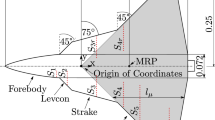Abstract
This investigation elucidates the effects of Reynolds number (Re) and angle of attack (α) on the boundary-layer flow patterns, aerodynamic performance, flow behaviors and vortex shedding. This investigation applies a finite NACA 0012 forward-swept wing with the forward-sweep angle (φ) of 15°. The Reynolds numbers were tested in the range of 4.6 × 104 < Re < 105. The wing chord length is 6 cm and the semi-wing span is 30 cm, such that the full-span wing aspect ratio is 10. The surface oil-flow scheme was utilized to visualize the boundary-layer flow structures. The hot-wire anemometer was applied to measure the vortex-shedding frequency behind the forwardswept wing. Furthermore, a force-moment sensor was applied to measure the aerodynamic loadings. The surface oil-flow patterns are classified into six characteristic flow modes — separation, separation bubble, secondary separation, leading-edge bubble, bubble extension and bluff-body wake modes. Additionally, the output of force-moment sensor and the visualized boundary-layer flow configurations indicate that the aerodynamic performance is closely related to the boundary-layer flow behaviors. Furthermore, the boundary-layer flow stalled in the leading-edge bubble mode. Moreover, the vortex-shedding frequency behind the forward-swept wing shows that the vortexshedding frequency at low α exceeds that at high α.
Similar content being viewed by others
References
C. Breitsamter and B. Laschka, Vortical flowfield structure at forward swept wing configurations, Journal of aircraft, 38(2) (2001) 193–207.
S. F. Hoerner, Fluid-Dynamic Drag: Practical Information on Aerodynamic Drag and Hydrodynamic Resistance, 2nd ed., Midland Park, N.J. (1958).
S. F. Hoerner and H. V. Borst, Fluid-Dynamic Lift: Practical Information on Aerodynamic and Hydrodynamic Lift, Brick Town, N.J. (1975).
G. Redeker and G. Wichmann, Forward sweep -A favorable concept for a laminar flow wing. Journal of aircraft, 28(2) (1991) 97–103.
T. M. Weeks and L. H. Leet, The X-29A forward swept wing advanced technology demonstrator program, Proc. of the International Conference on Forward Swept Wing Aircraft, Univ. of Bristol, Bristol, U. K. (1982) I.1.1–I.1.8.
R. K. Nangia, Aspects of forward swept wing research at the University of Bristol, Proc. of the International Conference on Forward Swept Wing Aircraft, Univ. of Bristol, Bristol, U. K. (1982) I.9.1–I.9.24.
I. H. Abbott and A. E. von Doenhoff, Theory of Wing Section, Dover Publications, New York (1959).
L. C. Squire, The motion of a thin oil sheet under the steady boundary layer on a body, Journal of Fluid Mechanics, 11 (1961) 161–179.
S. C. Yen and C. M. Hsu, Influence of boundary layer behavior on aerodynamic coefficients of a swept-back wing, ASME Journal of Fluids Engineering, 129(6) (2007) 674–681.
M. Gad-el-Hak and C. M. Ho, Unsteady vertical flow around three-dimensional lifting surfaces, Journal of aircraft, 24(5) (1986) 713–721.
S. C. Yen and L. C. Huang, Flow patterns and aerodynamic performance of unswept and swept-back wings, ASME Journal of Fluids Engineering, 131(11) (2009) 111101 1–10.
P. B. S. Lissaman, Low Reynolds number airfoils, Annual Review of Fluid Mechanics, 15 (1983) 223–239.
H. Tennekes and J. L. Lumley, A First Course in Turbulence, MIT Press, Cambridge (1972).
J. H. Lienhard, Synopsis of Lift, Drag and Vortex Frequency Data for Rigid Circular Cylinders, Research Division Bulletin 300, Washington State University (1966).
R. F. Huang and C. L. Lin, Vortex shedding and shearlayer instability of wing at low-Reynolds numbers, AIAA Journal, 33(8) (1995) 1398–1403.
A. Roshko, On the development of turbulent wakes from vortex streets, NACA Report 1191 (1954).
Author information
Authors and Affiliations
Corresponding author
Additional information
Recommended by Associate Editor Simon Song
Kuo-Ching San was born in Taichung, Taiwan, R.O.C., on June 28, 1969. He received the B.S. degree from Air Force Academy, Kaohsiung, R.O.C., in 1992, the M.S. degree from Polytechnic University, Brooklyn, NY, in 1997, and the Ph.D degree from the National Taiwan University, Taipei, R.O.C., in 2007. His research interests include the analysis of flow patterns on wing airfoils and flame patters on unconfined combustion.
Rights and permissions
About this article
Cite this article
San, K.C., Fei, Y.F. Characteristic flow patterns and aerodynamic performance on a forward-swept wing. J Mech Sci Technol 26, 3103–3110 (2012). https://doi.org/10.1007/s12206-012-0922-5
Received:
Revised:
Accepted:
Published:
Issue Date:
DOI: https://doi.org/10.1007/s12206-012-0922-5




